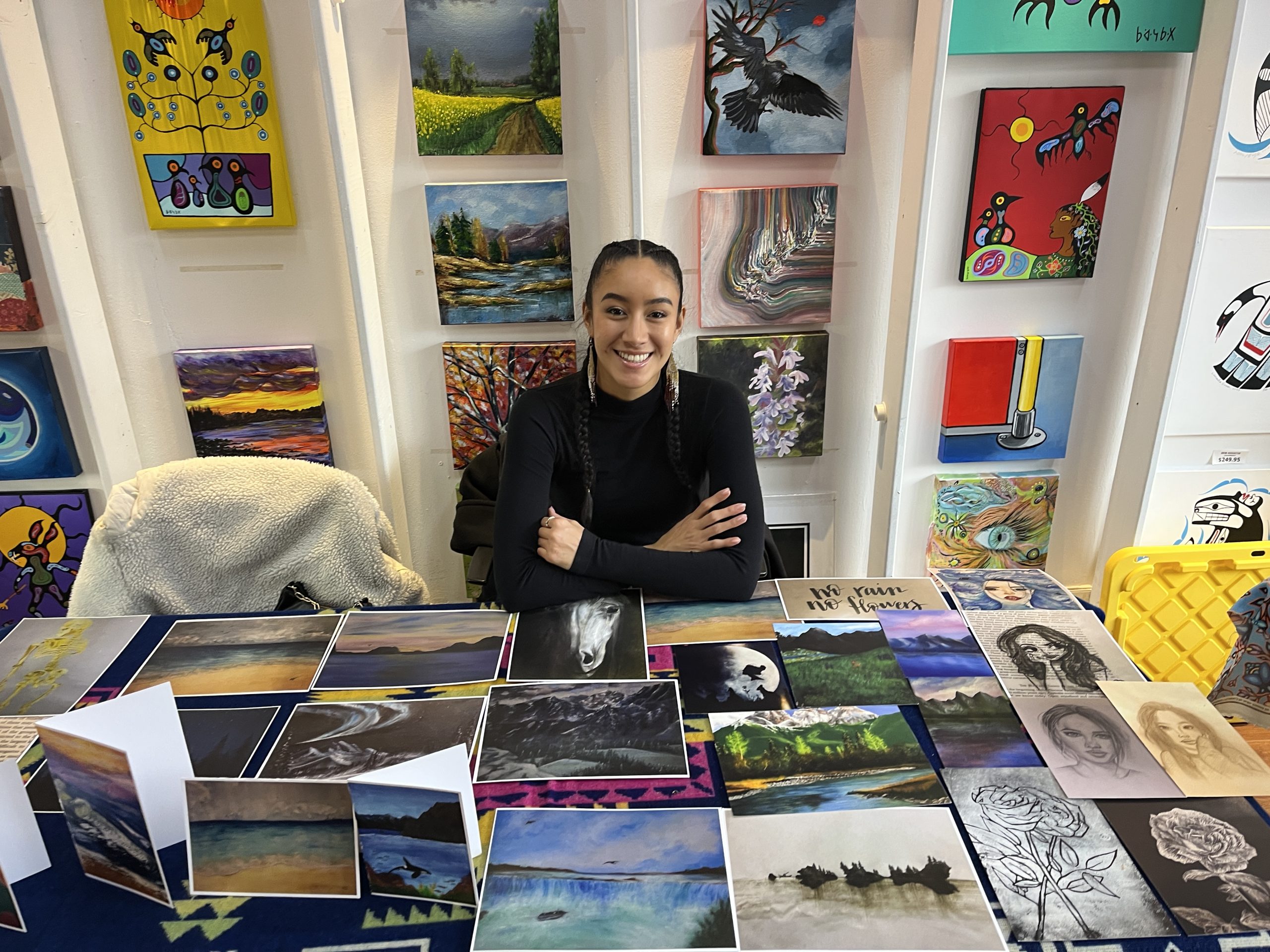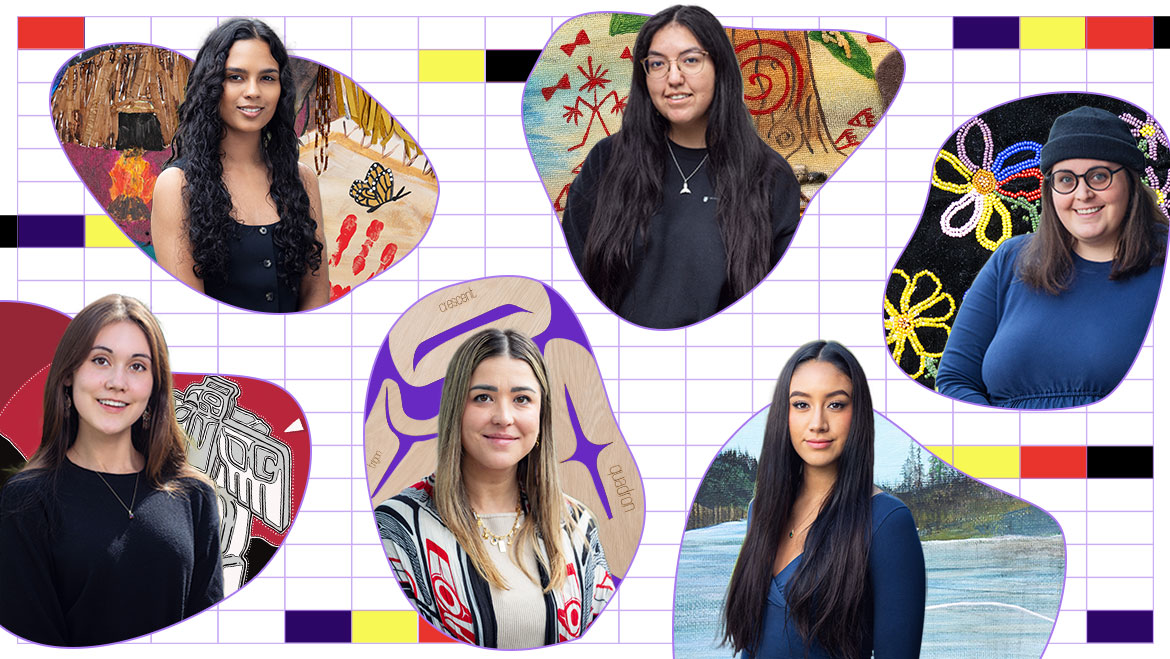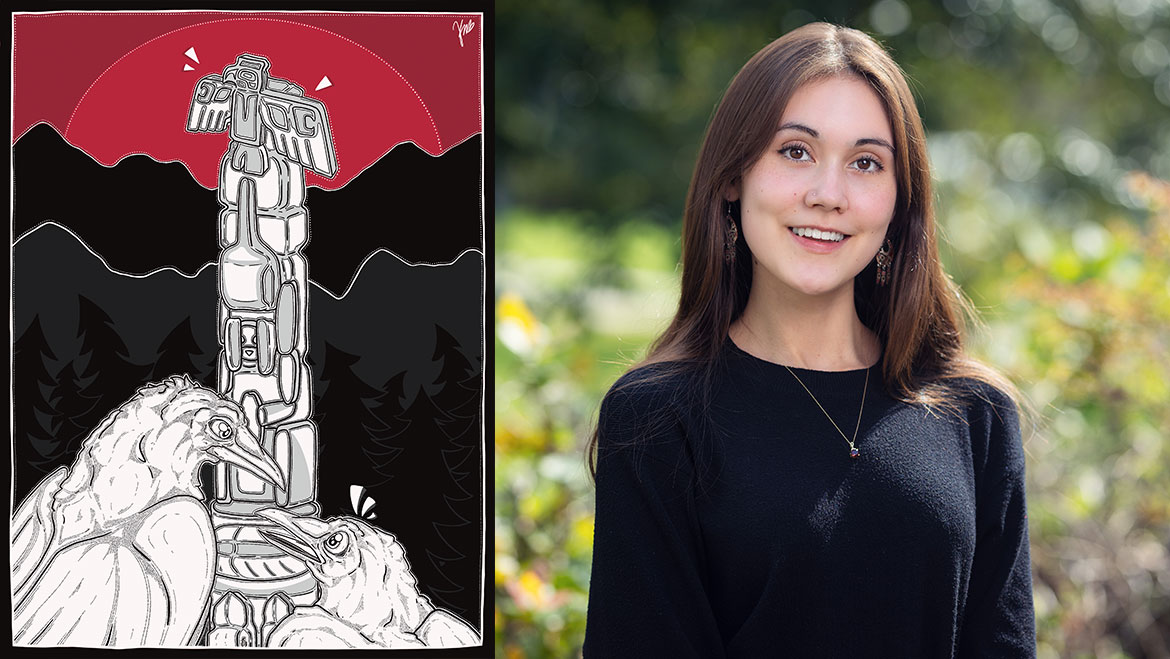

Photo by Martin Dee
Kineena is part of the Anishininiimowin First Nation reserve, also known as Big Trout Lake, in Northern Ontario at Kitchenuhmaykoosib Inninuwug, and was named after her grandmother, who was part of the reserve.
Growing up, she was involved in ceremonies and a braiding sweetgrass program, and she found a way to continue contributing to the community by being the deputy treasurer for the Indigenous Student Society. Through recently completing her degree in psychology, Kineena is paving her path into getting her Master’s in business and working in real estate. Kineena also aims to find innovative ways to help the environment through increasing the reusability of products and reducing waste.
We interviewed Kineena about the painting she created for the Indigenous Symbols and Signifiers initiative, which answers the question: What symbols represent belonging in your culture? Here’s what Kineena has to say.
About Kineena and her inspiration
I took Psychology because, in my first year, I was in general studies and took a variety of courses. At first, I thought I wanted to go into science, but then I applied to UBC and decided to study psychology. I wanted to choose something I found interesting and something I could see myself doing well in. I was also planning to go to law school, but then I kind of pivoted—now I want to get my master’s in business.
With the theme of belonging, I was thinking about what tribe or Nation I belong to, and that’s Big Trout Lake, Ontario. I was looking at pictures of the lake and remembered the first ones I saw were from my great-grandmother, whom I was named after. She had some photos and wrote a book about her life and experiences. It’s not in English, so I can’t read it right now, but I think that was my first introduction to Big Trout Lake. I decided I wanted to paint that. Even though I’ve never been there, I was thinking about the kind of things people do there, like fishing, and how that’s a community activity—something that gets passed down.

Kineena's artwork
Original artwork created by Kineena that honours her ancestry, land- and water-based knowledge.

Kineena art stall
Photo provided by Kineena

Kitchenuhmaykoosib Inninuwug, Ontario flag
Photo provided by Kineena
Learning through quiet moments
My grandpa never told me much about his culture or his experiences growing up. He went to what they called day school, not a full residential school, but he didn’t talk about that either. So there were a lot of things I didn’t know. Growing up, I did go with my mom to cultural events and activities sometimes, which was how I learned about my culture and heritage, but I didn’t hear much from my grandparents.
Even though my mom took me to those activities, she also told me that some people don’t view Indigenous people positively. She said that when applying for jobs or trying to rent a place, it might be better not to mention my ethnicity, because I could be treated unfairly. From a young age, I internalized some of those negative stereotypes, and I think I chose to stay more anonymous instead of being open about my identity.
Honestly, one of the most common questions I get is about my ethnicity. The second is whether I play sports, probably because I’m tall. Sometimes I hesitated to say I was Indigenous, just because of those stereotypes.
“With the theme of belonging, I was thinking about what tribe or Nation I belong to, and that's Big Trout Lake, Ontario. I was looking at pictures of the lake and remembered the first ones I saw were from my great-grandmother, whom I was named after.”
Reconnecting with land and water through art
Coming to UBC, I got more involved in the Indigenous Student Society this year. I had gone to some of the spaces in previous years but wasn’t as engaged. This semester, I met more people and saw all the activities they were doing, like meetings and drum circles. Seeing people my age so proud of their culture was inspiring.
In my painting, the person fishing is drawn more as a silhouette, not fully detailed. That’s to reflect the energy people may carry when it comes to culture, and how that can sometimes prevent cultural knowledge from being passed down. But I think cultural activities, groups, and community building can help strengthen identity and create pride so that culture isn’t lost or forgotten. That was a big part of my inspiration.


I also gave the fish an Indigenous art style. It’s a more modern way of fishing, too—a blend of tradition and the present. Even with changes over time, people can still stay connected to their culture.
I just looked at a lot of pictures of Big Trout Lake, Ontario. There aren’t big mountains—just mostly grass, trees, and rocks. That’s why I painted it that way. I chose colors that felt uplifting, cheerful, and hopeful.
Finding belonging in culture and creativity
The Indigenous Student Society meets every Monday to talk about everyone’s roles, upcoming events, and planning. Seeing how much effort everyone puts in—and they’re all volunteers—is really meaningful. I became the treasurer in January when they needed someone, and I thought it was a chance to learn more about finance. Even though my role is small, it’s been great to see everyone working together toward something they care about.
They do a lot of shared meals, like the Three Sisters event, and the food is always really good. They also had a painting session at the Longhouse—that helped me reconnect with painting, which I hadn’t done in a while. They’ve done other activities too, like planting or painting props for events. It’s been great to hear how others are involved and to get invited to participate in things outside of school.
I recently participated in an art market, and a girl came up to me and said, “Your paintings are so beautiful. Seeing them made my day.” That really touched me because that’s the kind of art I want to create. Even if it doesn’t carry some deep meaning every time, if it can bring someone joy or comfort, that’s enough. That’s the kind of work I want to do.


